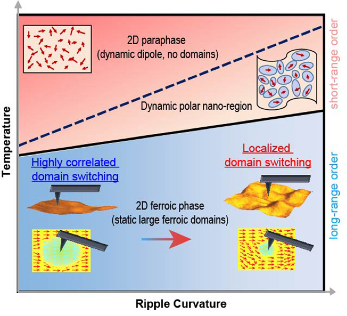Rippling ferroic phase transition and domain switching in two-dimensional materials
Yang Yang*, Hongxiang Zong, Xiangdong Ding, Jun Sun
State Key Laboratory for Mechanical Behavior of Materials, Xi’an Jiaotong University, Xi’an 710049, China
EXTENDED ABSTRACT: 2D ferroic and multiferroic materials recently sparked much interest owing to their potential applications in emerging 2D functional devices. 2D materials possess another unique degree of freedom, i.e. low-energy flexural out-of-plane bending mode, which becomes more significant with reducing thickness. Remarkably, the flexural mode also leads to the formation of ripples, a class of intrinsic structural defects in 2D materials. Flexural mode induced ripples add an additional dimension in 2D materials with potential impact on the physical properties such as magnetic properties, electronic properties and mechanical/friction properties etc. However, the effect of ripples on 2D ferroics has not been reported. It is difficult to investigate ripple effects by experiments quantitatively. Traditional computation/simulation methods are also limited by the trade-off between the accuracy and efficiency. Herein, we use machine learning to develop an interatomic potential for monolayer GeSe, combining the accurate DFT calculation and efficient molecular dynamics simulations. With the help of this machine learning potential, we present a molecular dynamics study of the effect of ripples on the temperature-induced ferroic phase transition and stress-induced ferroic domain switching in ferroelastic-ferroelectric monolayer GeSe. Ripples stabilize the short-range ferroic orders in the high-temperature phase with stronger ferroicity and longer lifetime, thereby increasing the transition temperature upon cooling. In addition, ripples significantly affect the domain switching upon loading, changing it from a highly correlated process into a ripple-driven localized one where ripples act as source of dynamical random stress. Our results reveal the fundamental role of ripples on 2D ferroicity and provide theoretical guidance for ripple engineering of controlled phase transition and domain switching with potential applications in flexible 2D electronics [1].

Figure 1. Ripple effects on 2D ferroic phase transition and domain switching.
REFERENCES
[1] Y. Yang, H. Zong, J. Sun and X. Ding, Advanced Materials, (2021) 2103469

Yang Yang has completed his PhD at the age of 28 years from Xi’an Jiaotong University. He is an assistant professor of school of materials science and engineering in Xi’an Jiaotong University. He focuses on the deformation and phase transformation in mateirlas by molecular dynamics simulations. He has published more than 5 papers in reputed journals such as Adv. Mater., Adv. Func. Mater., and Acta Mater. etc.